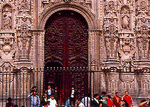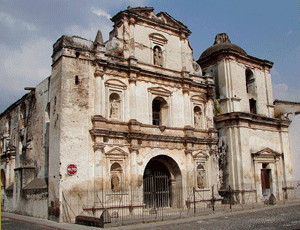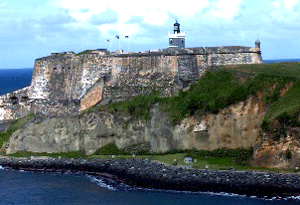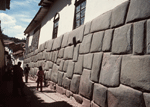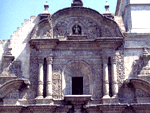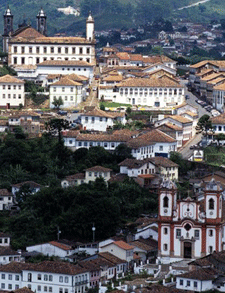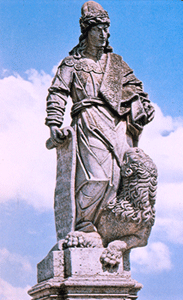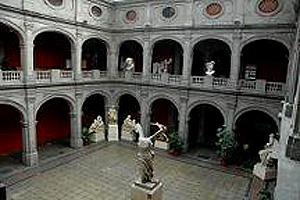Notes
on Latin American Baroque and Neoclassical Humanities
1600 – 1810
I. Baroque in Mexico:
General Characteristics
In Mexico the
Baroque period ushers in a burst of color with polychrome plasterwork, red
volcanic stone mixed with white limestone, and colorfully glazed tile work (azulejos) and ceramic pottery. The
effect is that of exaggerated extremes mixed with organic sensuality.
Surprises, effects, and novelties for their own sake dominate all kinds of arts
from common crafts to high literature and music. During the 17th
century we find mistilineal shapes (curves and straight forms), three-lobed
arches in architecture, and even inverted pyramids for pilasters. In addition,
as is suggested by the notion of Baroque humanities wherever it appears (Latin
America, Spain, Italy, etc.), Mexican baroque humanities demonstrate a
profusion of adornment, complicated façades, abundant foliage, plaster darts,
crossings, coilings, scrolls, and conical shapes mixed with traditional shapes.
During
the 17th century especially, Mexican creoles (privileged native-born
Mexicans of European ancestry) try to immortalize both their Iberian forbears
and the Spanish conquistadors, whose fame they idealize and exalt. Latin
American syncretism of forms and content are particularly prevalent in Mexico:
their humanities give no rest to the beholders eyes or mind. In addition,
however, in these baroque arts we find a symbiosis of purely creole baroque
tastes and mestizo popular arts: pre-Columbian intertwined serpents, exotic
birds (i.e., the quetzal bird), suns, moons, enchanted interiors, roasted
meats, swarms of heads, carved foliage, drowned devils, tropical fruit, plumed
military headdresses, celestial Indian courts, crucifixes on corn husks (i.e.,
native Mayan culture), Indiatids (sculpted figures of indigenous Mexicans used
as columns; e.g., on the Montejo
mansion in Mérida). In fact, one could say that, according to
Mexican Baroque humanities, God (god) is seen as a native Mexican. Think in
particular of the pervasive influence of the cult of the Virgen
de Guadalupe in Mexican Catholic religious beliefs and practices.
The term horror vacui is well suited to the Mexican Baroque. Mexico's
greatest architect during this period is Lorenzo Rodríguez (1704-1774). He
designed the Sagrario chapel (1749-1769), which sits next to the Catedral
Metropolitana on the Zócalo in the center of Mexico City. This chapel is a perfect example
of baroque disequilibrium; its airy filigree, florid carvings, and imaginative
choir screen are designed specifically to dazzle the eyes, the mind, and the
spirit. This style is called Churrigueresque (churrigueresco), from the Spanish architect José Benito Churriguera
(1665-1725),
because it is the last and extreme development of baroque architectural style.
In
terms of the visual arts, whereas sculptures and paintings were either imported
directly from Spain or they were calqued or imitated directly from Spanish
models and styles during the 16th century, in the 17th
century, for the most part, paintings were still brought into Mexico from Spain
while sculpture was somewhat freer, in that indigenous relief decoration was
permitted and enjoyed. For example, friezes depict local fruit, flora, fauna,
and physiognomies including Aztec virgins. In fact, the baroque spirit is so
deeply rooted in Mexican consciousness that it develops its own style beyond
anything seen in the metropolis, Spain. Wealthy Mexican creoles are
able to afford to commission products of the humanities on their own. Herein,
then, Latin American nationalism arises. But it will not come to fruition until
the early 19th century.
In Mexican baroque literature, three figures stand
out: Bernardo de Balbuena (1561-1627), Carlos Sigüenza y Góngora (1645-1700), and
Sor Juana Inés de la Cruz (1648-1695). The last two of these figures
have their own descriptions on this website. As for Bernardo de Balbuena, his
major literary masterpiece deserves mention here: La grandeza mexicana (Mexican Grandeur, 1604). In this long and
elegant poem, he describes the colonial city of Mexico. He gives a profusion of
details about the complicated and beautiful city as it was about 80 years after
it was conquered from the Aztecs and as it had grown into the gracious capital
of the viceroyalty of New Spain (Nueva
España). In flowing, lyrical verses, he gives lush word pictures of the city's
geography, climate, surroundings, architecture, flora, fauna, and human
residents. The poem is both high Renaissance and early baroque in style, yet,
as is suggested by its Renaissance qualities, it has an elegant simplicity; at
the same time, however, it contains very complicated baroque metaphors, word
plays (conceptismo), and a vocabulary
that shows off his erudition (culteranismo).
Overall, La grandeza mexicana
demonstrated early Mexicans pride in their new, mixed, semi-independent
culture.
II. Baroque in Central America and Caribbean
In these regions there are fewer
baroque extremes than one finds in Mexico. There is less use of
polychrome painting; white is used more often; there is less stone carving; the
architecture uses more wood; and towers are thicker and wider. In Central America one finds motifs typical of the region:
palm leaves, stylized flowers, ears of corn, and the like.
Early in the baroque Colonial
period, Antigua, Guatemala,
was a major cultural center that rivaled Mexico City,
Lima and Cuzco in
Perú, Potosí in Bolivia, and
Ouro Preto in Brazil.
Sadly, Antigua was destroyed many times by
earthquakes, and it was almost entirely abandoned. Its population declined from
a peak population of 60,000 in 1770s to 35,000 now, and it is growing once
again since it has been declared a UNESCO World Heritage Site. The image below
gives an idea of some of the past glories of colonial architecture in Antigua; for a virtual tour of Antigua, click on this
image:
Two other
sites that had prime examples of colonial architecture and art are Nicaragua and
Panamá. Sadly, the English pirate Henry Morgan destroyed the greatest early
Panamanian architecture in 1671, whereas Nicaragua's beautiful church
monuments were destroyed by the American filibusterer William Walker in the
1850s.
As one
recalls from earlier discussions of the period of Spanish discovery and
conquest in Cuba, mestizo
art does not take root on the largest of the islands of the Caribbean.
This is due to the fact that native peoples were eliminated from the island;
hence, there were no indigenous crafts artisans, nor was there an indigenous
labor force, who were the craftsmen who worked local themes into churches and
other buildings. In Cuba,
therefore, one finds more Spanish influence. The same is true in Puerto Rico. Among the most notable buildings in San
Juan, Puerto Rico, is the Castillo de San Felipe del Morro, which is an
elaborate defensive fortification with a number of forts, castles, bastions,
spiked walls, guardhouses, subterranean passages, barracks, jails, prisons, and
more.
III. The Baroque in Quito, Ecuador, and Nueva
Granada (Colombian and Venezuela)
The
first Latin American school for the arts was created in Quito in 1534. This particular school and
others that followed later throughout Ecuador and Nueva Granada (New Granada)
trained many native artists and artisans, but they all followed Spanish
European patterns. As a result, their art includes abundance, richness, and
variety. As an added element, Spanish Franciscan missionaries brought Asian
elements to these Latin American regions. As you might expect, then, artists
and craftmen followed rigorous codes for the color they used and for styles of
the vestments they created for statues of the saints and for the Catholic
clergymen. Three of the most important names in these regions are the architect
Fray (Brother) Antonio Rodríguez of Guápulo (near Quito,
Ecuador) and two women, Sor
María Estefanía de San José
and Sor Magdalena.
IV. The Baroque
in Perú and Chile
In Perú
during the two centuries covered on this page, architecture shows signs of a
Gothic revival. However, in Cuzco
one continues to find a strong native substratum of styles and ideas. This
means that we find layering and syncretism in the Peruvian humanities during
this period. The entire city is created on two levels, figuratively and
architecturally: Inca stone walls were used on the bottom as the foundations
and bases for Spanish-style houses. The lower half, then, gives a sense of
heaviness, darkness, and solidity. Above the stone foundations one finds
typical Spanish windows with ornamental wrought-iron bars, and on the roof
curved red Spanish tiles. Architecture in Arequipa
and Cuzco have
superb examples of this fusion of the Spanish baroque style with indigenous
bases. You may link through the following image for an architectural tour of Cuzco.
In the
seventeenth century, what we have been identifying as syncretism continued with
what Gauvin Alexander Bailey, an expert in Peruvian art and architectural
history, has called the “Andean hybrid baroque.”[1] He
uses this term instead of either syncretism, which we are using in this
textbook, or “Mestizo Style,” which other experts often use, for these reasons:
“”Andean hybrid baroque,” a term that I think is most accurate, he says,
“encompasses a wide range of meanings … including the style’s geographic
location and its cultural admixture, but it is more useful for an art
historical study because it relates more specifically to how this culture fits
into an international stylistic movement” (Bailey, p. 2). The Andean hybrid
baroque, this expert says, began in Arequipa,
Perú, in the 1660s and spread throughout the general Inca region until
the native rebellions in the late seventeen hundreds. For examples of this
style see the church of the Compañía (Jesuit) in Arequipa:
By
contrast with Arequipa and Cuzco, Lima, which was the center of Spanish
colonial and power in South America, shows the face of a more Europeanized
city. Most of the sculptors and carvers were imported directly from Spain for work
in the viceregal capital. Some of the finest wood carving on church choir
stalls, for example, is found in Lima due to the
importation of skilled carvers from Andalucía,
Spain. Higher
up in the Andes, in Alto Perú, however, one
finds mixed (i.e., mestizo) forms and
styles. The fabulously rich silver mining city of Potosí
in present-day Bolivia
exemplifies the fusion of European and indigenous elements.
In
literature, three writers stand out: Felipe Guamán Pomo de Ayala (ca. 1530-ca. 1615), the Inca Garcilaso de la Vega (1539-1616),
and Juan del Valle y Caviedes (1652-1697). Guaman Pomo de Ayala is known for
the prose chronicle, El
Primer Nueva Coronica y Buen Gobierno
(The First New Chronicle and Good Government), written in 1615. It had
disappeared for three centurias until it was rediscovered in the 1908. It takes
the form of a thousand-page letter directed to the king. In it he describes the
terrible situation of his own Quechua people, the indigenous Peruvians. Guamán
Pomo's Spanish style is highly influenced by Quechua; however, he also shows
that he knew some Latin.
The Inca Garcilaso de la Vega,
who was born in Cuzco,
was the illegitimate son of a Spanish conquistador and an Inca princess. One
can say that the Inca Garcilaso is truly significant for Latin American
humanities because he is the first major writer born in the Americas. With
him, then, Latin American literature per se begins. He blends both a thorough
knowledge of Spanish culture and Inca culture. On his father's side he was
related to the family of the great Spanish Renaissance writer, Garcilaso de la
Vega, and from his mother he learned Quechua and the traditions of her Inca
people. He produced three major works: La
Florida (1605), which chronicles Hernando de Soto's
expedition to Florida.
He translated a major Renaissance work by León Hebreo, Dialoghi d'Amore (Dialogues of Love), from Italian to Spanish. And
his masterpiece is the Comenatarios reales
(The Royal Commentaries, 1609 and 1617). Writing in Spain in the best 16th
century Spanish style, in this third work he tells about the glories of Inca
history, language, religion, and humanities.
Writing in Lima in the peak of the Spanish-American Baroque
period, Valle y Caviedes lived a life of debauchery: women, wine, and gambling.
He wrote biting satire against medical doctors in the genres of poetry,
ballads, festive poems, and epigrams. All of his works were published
posthumously in a work title Diente del
Parnaso (Tooth of Parnassus). In addition, he wrote dramatic and comic
essays in the style of the great Spanish baroque writer Francisco de Quevedo,
sonnets, and religious poetry. In a "Carta" (letter) to Sor Juana
Inés de la Cruz, he informs us of his pride in his achievements, the fact that
he was self-taught and that he held no superstitions. He died of alcoholism,
but, in a word, he was probably the best colonial Peruvian poet.
In Chile
during the Baroque period, there were no major developments in the humanities.
Rather, Chile
developed rapidly during the Neoclassical period in the 18th
century.
V. The Baroque
in Brazil
Generally
speaking, Brazilian colonial baroque style shows a tendency toward more
sensuality than in other regions of Latin America:
more seductive angels and feminine attributes as ogled by fauns with lewd
expressions, for example. Also, in Brazil, we see new forms with
mulatto and African values, plus there is a tendency toward grace side by side
with frivolity. This is due to the rococo (a development of the Italian and
French Baroque especially) styles imported by the imperial Portuguese court
(see the Brazilian information page for the period from 1549 to 1807). It is
important to note that the Portuguese in Brazil did not use a native labor
force or artisans in either architecture or art; hence, there is no conflict
between native forms and content on the one hand and Portuguese elements from
the Baroque period. In fact, what one finds in Brazil
is one of the most extreme baroque developments in all of Latin
America. This includes an element of "tropicalization"
(i.e., the use of tropically exuberant flora and fauna) in the 18th
century leading to incredible interior ornamentation including dazzling church
altars. Immense prosperity came Portuguese Brazil in 1693 when gold was
discovered at Ouro Preto. Here is a standard picture of downtown Ouro Preto:
As a result,
Asian artisans and craftsmen were imported into Brazil
from Portuguese possessions in Asia. These
laborers in the field of art and architecture added both a new dynamism and an
Asian flavor to regional styles, especially in the interior of the colony. In
terms of sculpture and painting, the Brazilian Baroque period finds a profusion
of frescoes. In addition, there are two figures that stand out: Manuel da Costa
Ataíde, who was the greatest artist of Minas Gerais. He is known especially for
his paintings of negros (African
Brazilians) and mulattoes on high altars, ceilings, and stations of the cross.
The other great figure of the Brazilian Baroque is Aleijadinho (1730-1814): for
him, see the separate web page in our Baroque
Index.
In fine, the so-called Golden Age of Brazilian baroque art covers the years
from 1750-1807. In this last period of the Portuguese imperial colony in Brazil
we see an integration of visual and spatial arts in addition to excellent
polychrome woodcarving.
VI. Late 18th
Century
The neoclassicism that was so prevalent in France throughout the 18th century
entered Latin America late in the 18th century, as, indeed, it did
also in Spain and Portugal. Among
such influences were the ideas of (1) independence from the metropolis (mother
country), (2) a move away from Iberian cultural and baroque styles and ideas,
and (3) imitation of French elements of art and ideology. Much of French
neoclassicism entered Latin America not directly from France, but rather mediated and transferred
indirectly through the United States
during the first years of American (i.e., U.S.A.) independence (1776-1810).
What happened in Latin America is fairly
complex, however. Land-holding Creoles (well-to-do criollos: non-mestizo and
non-native Latin Americans) led various independence movements, which were
also, much like those in the U.S.A.,
movements that asserted cultural, political, and national maturity. The highly
developed cultural forces of "Baroque Latin America" rejected
independence movements, but "Neoclassical Latin America" favored
independence. These two Latin Americas (a huge oversimplification, but roughly
useful as an introductory notion) existed all over the continent, but there
were also regions that were dominated by one force or the other depending on
the differences in local or region histories. While one finds imported French
architects throughout Latin America, nevertheless, the highest degree of
neoclassical influence occurred in Mexico
and Brazil.
The Real Academia de Bellas Artes de San Carlos
(royal academy of fine arts) was opened in Mexico City
in 1785, for example, imitation of the royal academies of France and its own imitation in Spain.
The academy's full name was Academia de las Tres Nobles Artes de San Carlos de la Nueva España
(academy of the three noble arts of Saint Charles of New Spain). It was named
in honor of Spain's
and Spanish-America's king, Carlos IV, who was a patron of Neoclassicism. The
lead architect was Antonio González Velázquez.
The most renowned sculptor in Mexico was Manuel Tolsá (Spain, 1757-Mexico,
1825). He became director of this Neoclassical academy in1790. In addition to
his work as the Academy's director, he supervised draining the lake surrounding
Mexico City, he
reforested the city's downtown park (la Alameda Central), he created furniture
and military cannons, he opened a bath house and a carriage factory, and he
built a ceramics kiln.
In South America's Southern Cone (el cono sur: Chile,
Argentina, Uruguay),
neoclassical influence was easily accepted due to its distance from baroque-dominated
Perú. This is because there were no strong baroque movements either in the
Southern Cone or in Venezuela.
Remember that the Viceroyalties of Nueva Granada and Río de la Plata were
established in 1740 and 1776, respectively. In other words, these South
American regions became recognized as independent entities when Neoclassicism
was beginning to dominate the humanities in Europe and Latin
America.
Toward the end of the 18th century,
intellectuals in Latin America began to make
the transition from Neoclassicism to Romanticism. They began to go beyond a
strict base in reason and rationalism toward sentimentalism. Instead of
thinking about the world as a mechanism, they began to venerate nature and its
organic processes. Nevertheless, neoclassical political themes still resonate
during this transitional phase. Among these themes are liberalism in which
state and religious absolutism are opposed; and humans (men and women) are
dignified and given independence; liberty and progress are valued. Literature
is no longer confined in a priori academic and intellectual rules. It is no
longer either a rhetorical exercise or a frivolous entertainment; rather
literature is taken very seriously. Writers become independent professionals
who feel responsible for improving the welfare of all mankind: they try to
become akin to poet-priests. Two of the most important writers during the
transitions times between the end of the neoclassical period and beginning of
the Age of Romanticism are José Joaquín Fernández de Lizardi (México,
1776-1827) and Andrés Bello (Venezuela, 1781-1865). For brief commentaries on
each of these two writers, click on the following images:
|
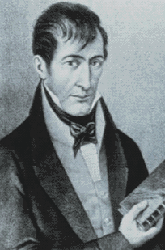
Lizardi
|
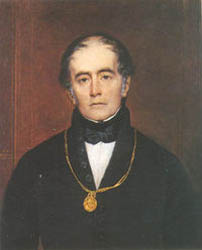
Bello
|
VI. End of
European Colonial Hegemony, 1807-1810
In brief, there were five
principal reasons why France,
Spain, and Portugal began
to lose their American colonies in the 18th and 19th
centuries.
1. France lost its five colonies
(Canada, Acadia, Hudson Bay, Newfoundland, Louisiana) included in its North
American territories of Nouvelle-France (New France) (a) when it lost the French
and Indian War and the Seven Years' War to
England in 1763; (b) when it sold Louisiana to the United States of America in
1803; and when it lost Haiti's War of Independence in 1804.
2. Napoleon Bonaparte invaded Spain in 1808, causing Latin American Creoles to
fight against the French-controlled mother country (i.e., for independence from
Napoleon's Spain and against
the new king, José Napoleón, in Spain).
3. The liberal Spanish
constitution of promulgated by French-influenced Spanish intellectuals in 1810
caused conservative Latin American Creoles to reject colonial control by
Spain. At the
same time, the new Spanish Bourbon king, Fernando VII, was taken prisoner by
Napoleon Bonaparte in 1810, again causing Latin American Creoles to rebel
against a Spain
that was no longer free.
4. In general, powerful and rich
Latin American Creoles realized that they possessed basic cultural patterns
different from cultural norms that had been and were then prevalent in Europe.
5. In 1807 the royal court of
Portugal left Europe (i.e., the capital of Lisboa / Lisbon,
Portugal), established
itself in and near Rio de Janeiro, Brazil, and then, in 1821, returned to Lisbon, thereby leaving its giant colony of Brazil free. Brazil, therefore,
did not have to fight a war of independence.
